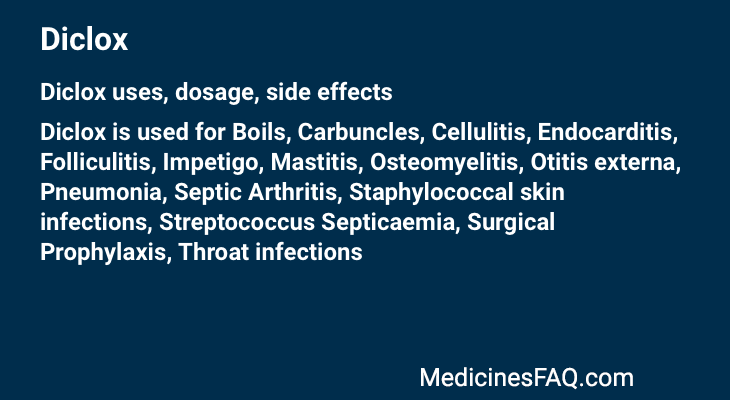Diclox
Diclox Uses, Dosage, Side Effects, Food Interaction and all others data.
Diclox inhibits bacterial cell wall synthesis by binding to 1 or more of the penicillin-binding proteins (PBPs) which in turn inhibit the final transpeptidation step of peptidoglycan synthesis in bacterial cell walls. Bacteria eventually lyse due to ongoing activity of cell wall autolytic enzymes (autolysins and murein hydrolases) while cell wall assembly is arrested.
Diclox is a beta-lactamase resistant penicillin similar to oxacillin. Diclox has in vitro activity against gram-positive and gram-negative aerobic and anaerobic bacteria. The bactericidal activity of dicloxacillin results from the inhibition of cell wall synthesis and is mediated through dicloxacillin binding to penicillin binding proteins (PBPs). Diclox is stable against hydrolysis by a variety of beta-lactamases, including penicillinases, and cephalosporinases and extended spectrum beta-lactamases.
| Trade Name | Diclox |
| Availability | Prescription only |
| Generic | Dicloxacillin |
| Dicloxacillin Other Names | Dicloxacilina, Dicloxacillin, Dicloxacillina, Dicloxacilline, Dicloxacillinum |
| Related Drugs | amoxicillin, prednisone, doxycycline, ciprofloxacin, cephalexin, metronidazole, azithromycin, clindamycin, ceftriaxone, levofloxacin |
| Weight | 250mg, 500mg, 75mg, 100mg, 50mg |
| Type | Capsule, Tablet, Tablet Sr |
| Formula | C19H17Cl2N3O5S |
| Weight | Average: 470.326 Monoisotopic: 469.026596773 |
| Protein binding | Binds to serum protein, mainly albumin. |
| Groups | Approved, Investigational, Vet approved |
| Therapeutic Class | Penicillinase-resistant penicillins |
| Manufacturer | Novartis (bangladesh) Ltd, Wns Field Pharmaceuticals |
| Available Country | Bangladesh, Pakistan |
| Last Updated: | September 19, 2023 at 7:00 am |

Uses
Diclox is used for Boils, Carbuncles, Cellulitis, Endocarditis, Folliculitis, Impetigo, Mastitis, Osteomyelitis, Otitis externa, Pneumonia, Septic Arthritis, Staphylococcal skin infections, Streptococcus Septicaemia, Surgical Prophylaxis, Throat infections
Diclox is also used to associated treatment for these conditions: Animal bite, Impetigo, Infection caused by staphylococci
How Diclox works
Diclox exerts a bactericidal action against penicillin-susceptible microorganisms during the state of active multiplication. All penicillins inhibit the biosynthesis of the bacterial cell wall. By binding to specific penicillin-binding proteins (PBPs) located inside the bacterial cell wall, dicloxacillin inhibits the third and last stage of bacterial cell wall synthesis. Cell lysis is then mediated by bacterial cell wall autolytic enzymes such as autolysins; it is possible that dicloxacillin interferes with an autolysin inhibitor.
Dosage
Diclox dosage
Adult: 125-250 mg 6 hourly. Doses may be doubled in severe infections.
Child: <40 kg: 12.5-25 mg/kg 6 hourly.
Should be taken on an empty stomach. Take at least 1 hr before or 2 hr after meals.
Side Effects
Hypersensitivity reactions (e.g. urticaria, fever, joint pains, rashes, angioedema, serum sickness-like reactions), nausea, vomiting, diarrhoea, stomatitis, black/hairy tongue, neurotoxic reactions, renal tubular damage, interstitial nephritis, eosinophilia, haemolytic anaemia, agranulocytosis, neutropenia, leucopenia, granulocytopenia, bone marrow depression, hepatotoxicity, cholestatic hepatitis.
Toxicity
Oral LD50 in rat is 3579 mg/kg. Symptoms of overexposure include irritation, rash, labored breathing, hives, itching, wheezing, nausea, chills, and fever.
Precaution
Patient with history of allergy esp β-lactam allergy, asthma. Pregnancy and lactation.
Interaction
Probenecid prolongs serum levels of dicloxacillin. Bacteriostatic drugs (e.g. chloramphenicol, tetracyclines) may antagonise the bactericidal effect of dicloxacillin. May reduce anticoagulant response to dicumarol and warfarin. May increase risk of methotrexate toxicity. May diminish the effect of live vaccines (e.g. typhoid vaccine).
Food Interaction
- Take on an empty stomach. Food decreases bioavailability.
[Moderate] ADJUST DOSING INTERVAL: Certain penicillins may exhibit reduced gastrointestinal absorption in the presence of food.
The therapeutic effect of the antimicrobial may be reduced.
MANAGEMENT: The interacting penicillin should be administered one hour before or two hours after meals.
Penicillin V and amoxicillin are not affected by food and may be given without regard to meals.
Diclox Hypertension interaction
[Moderate] Each 250 mg capsule of dicloxacillin sodium contains approximately 14 mg (0.6 mEq) of sodium, and each teaspoonful of the 62.5 mg<5 mL oral suspension contains approximately 67 mg (2.9 mEq) of sodium.
The sodium content should be considered in patients with conditions that may require sodium restriction, such as congestive heart failure, hypertension, and fluid retention.
Diclox Drug Interaction
Unknown: amoxicillin / clavulanate, amoxicillin / clavulanate, diphenhydramine, diphenhydramine, duloxetine, duloxetine, omega-3 polyunsaturated fatty acids, omega-3 polyunsaturated fatty acids, cyclobenzaprine, cyclobenzaprine, pregabalin, pregabalin, esomeprazole, esomeprazole, acetaminophen, acetaminophen, cyanocobalamin, cyanocobalamin, cholecalciferol, cholecalciferol
Diclox Disease Interaction
Major: colitis, marrow toxicityModerate: cystic fibrosis, sodium
Elimination Route
Absorption of the isoxazolyl penicillins after oral administration is rapid but incomplete: peak blood levels are achieved in 1-1.5 hours. Oral absorption of cloxacillin, dicloxacillin, oxacillin and nafcillin is delayed when the drugs are administered after meals.
Half Life
The elimination half-life for dicloxacillin is about 0.7 hour.
Elimination Route
Diclox sodium is rapidly excreted as unchanged drug in the urine by glomerular filtration and active tubular secretion.
Pregnancy & Breastfeeding use
Pregnancy Category B. Either animal-reproduction studies have not demonstrated a fetal risk but there are no controlled studies in pregnant women or animal-reproduction studies have shown an adverse effect (other than a decrease in fertility) that was not confirmed in controlled studies in women in the 1st trimester (and there is no evidence of a risk in later trimesters).
Contraindication
Hypersensitivity to dicloxacillin and other penicillins.
Storage Condition
Store between 20-25° C.
Innovators Monograph
You find simplified version here Diclox







